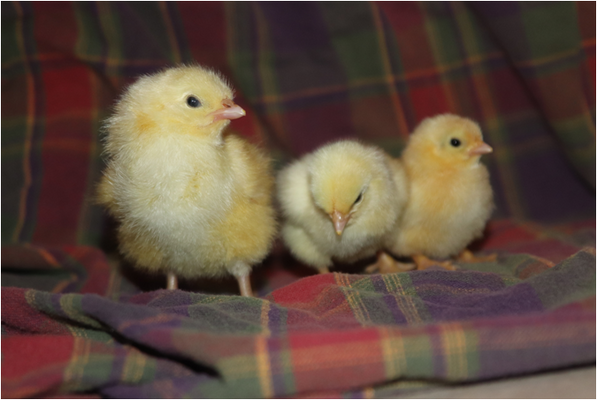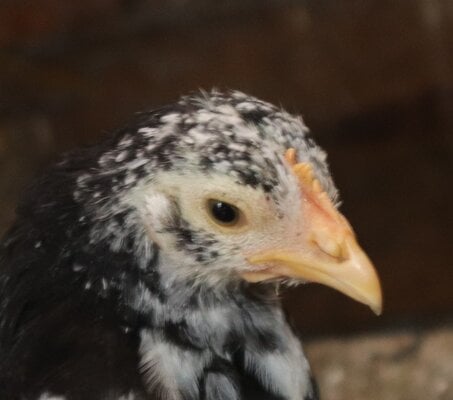Maybe you bought a mixed set of chicks. Maybe the chicks you bought are absolutely not what they’re supposed to be. Maybe you’re best friend’s neighbor knew a guy who’s brother’s wife had chicks and you bought a couple dozen. “What breed are they?” you ask. “Well, the guy I got them from said that his Aunt Josephine said that they were (insert obscure chicken breed hear)” This, as you may imagine, does not help you at all.
Identifying new born chicks is not always easy but below are some tips that may help you figure out what exactly you have. There are also a few pictures of certain breeds that I have raised as chicks for comparison.
Note: This article was written for purebred chicks not mixes.
Second Note: True bantams have no Large Fowl counterpart. Developed bantams were bred down from a Large Fowl version.
- What size is it?
- Bantam chicks, true or developed, can be the size of a strawberry up to a kiwi. Standards are kiwi to small tomato sized. If you know what size your bird is, it will help you narrow down what it could be.
- Does it have feathered legs?
- Only some breeds have a standard for feathered legs. Also look at where the feathers are. Marins only have feathers on the outside of their leg; Cochins have feathers on their legs and toes.
- What kind of comb does it have?
- You will probably have to wait for the comb to grow a bit before you are certain what type it is. Single combs and Rose combs are the most common, but there are also Pea, V, Chrysanthemum, Walnut, Strayberry, Cushion, and Buttercup combs.
- What is the temperament?
- Mediteranian breeds like Anconas and Leghorns are flightier then the American breed Plymouth Rocks and the English breed Sussex. If one of your chicks hates to be picked up then you may have a Mediteranian breed. Or it might just hate to be picked up.
- What size are the legs?
- Japanese Bantams can have very short legs. Very very short legs. It should be pretty obvious if you have a Japanese Bantam. Anconas have thinner delicate legs and Jersey Giants have legs like tree trunks.
- What color is it?
- Chicks with yellow fluff should grow up to be white or buff while chicks with black fluff should be black. Chicks with spots are harder. Brown or chipmunk turn to brown or black with brown patterns.
- How many toes does it have?
- Silkies, Sultans, Favorells, Houdans, and Dorkings are the only APA recognized breeds with five toes. All the other breeds have four.
- What color skin does it have?
- Breeds like Silkies and Sumatras have black skin while most others have yellow or pink.
- Does it have a crest?
- You may have to wait a bit for this to develop, but if it does you might have a Polish or an Appenzeller Spitzhauben. That one’s not recognized by the APA but it’s fun to say.
- How much fluff does it have?
- Cochins are fluffier than any other chick from day one. When you pick one up it is obvious they are more poofy. Cornish have a bare strip down there breast right along the keel bone, and Naked Necks or Showgirls should be obvious.
- How does it stand?
- Japanese Bantams have tails that stand straight up and are angled over the back in a condition called squirrel tail. Asils and Maylays stand almost vertical compared to horizontal like most chickens.
- And now for some pictures. I have tried to get one chick and one 6 week old picture. I also threw in some full grown birds.
- All these chicks were from quality stock so your chick might look a little different but they should be close enough for comparison.
Standard Buckeye
Buckeyes are an American breed that originated in Ohio. They are red with a black tail, orange legs, four toes, and a pea comb. They grow quickly and are good for meat and eggs.
Asiatic
Standard Mottled Cochin
Cochin's take two years to mature fully. This guy didn't lose his egg tooth until week two while every other chick lost theirs on day 2-3. Mottled Cochins have orange legs with dense feathering on the outer and middle toe, four toes, and black and white mottled feathers. They are very cold hardy, but slow growing. Cochins make very good broody hens.
English
Standard Light Sussex
Light Sussex are a breed that is rare in the US. They are white with black lacing in the cape or hackles, black in the wings, and a black tail. They have a larger single comb and pale white legs with four toes. A duel purpose breed, they are good for eggs and meat production.
Mediterranean
Standard Rose Comb Ancona
Anconas are a Mediterranean breed that originated in Italy. They are flightier and finer boned then a Plymouth Rock or a Wyandotte. They have a rose comb, orange clean legs, four toes, and a long beak. Anconas are very heat tolerant and are one of the few breeds that lay white eggs, but they are not good for meat because of there light build.
Standard Single Comb Ancona
Single Comb Anconas are the same as Rose Combs except for the comb difference.
Continental
Standard Barnevelder
Barnevelders are a Continental breed that originated in Holland. They are a duel purpose breed that can lay very dark brown eggs. Barnevelders have a single comb, four toes, orange clean legs and a chipmunk pattern as chicks. Adult Barnevelders should be black with a double lacing of brown for the plumage. They should also be free from shafting, feather shafts lighter than the rest of the feather, but that is difficult to breed.
Single Comb Clean Legged Bantams (SCCL)
Bantam White Plymouth Rock
Bantam White Rocks are a developed bantam. They are white with yellow legs, four toes, and a single comb. They are another duel purpose breed used for meat and eggs.
Bantam Black Rock
Black Rocks are also a developed bantam and are the same as White Rocks except they are black. They also may have some black in the feet.
Delaware Bantam
Delawares are another developed bantam. They have clean yellow legs with four toes, a small single comb, and an orange beak. For plumage, they are white with light black speckling on the cape and tail.
Black Tailed Buff Japanese Bantam
Japanese Bantams are true bantams which means they have no large fowl counterpart. BTB Japanese have a copy of a lethal gene that makes breeding difficult. They are tiny with very short yellow legs, a single comb, and a wide head. Japanese are squirrel tailed, meaning they hold their tails higher than 90 degrees. Due to their short legs, they are more prone to mites on the head.
Barred Japanese Bantam
Barred Japanese are also a true bantam and are like BTB Japanese but they have barred plumage.
Bantam Blue Orpington
Blue Orpingtons are a developed bantam which have grey feathers with a rounded tail and a single comb. They have yellow legs that can also include some grey and four toes. Orpingtons are good mothers, egg layers, and meat birds and are good in heat and cold.
Rose Comb Clean Legged Bantams (RCCL)
Bantam Black Wyandotte
Bantam Black Wyandottes are a developed bantam with a rose comb that follows the shape of the head instead of tapering to point like an Ancona. Their clean legs, feet, and beak are yellow and they have iridescent greenish black surface feathers with a dull black under color.
Bantam Chocolate Wyandotte
Bantam Chocolate Wyandottes are a newer breed. They are similar to Black Wyadottes except the Chocolate should have a brown tint to the feathers.
Quail Belgian Bearded D'Anvers Bantam Photos courtesy of @Amer
D'Anvers are a ornamental true bantam that originated in Belgium. Quail D'Anvers have a rose comb, beard, muffs, and four toes on clean, slate colored legs. They have black plumage with golden bay lacing and straw or gold highlights. D'Anvers are the only common Rose Comb Bantam breed with nine varieties recognized by the APA and 15 by the ABA.
Blue Quail Belgian Bearded D'Anvers Bantam Photos courtesy of @Amer
The Blue Quail variety is only recognized by the ABA. They are a true bantam that have four toes on clean slaty blue legs, muffs, and beards. Their plumage is blueish black with gold lacing and straw colored shafts.
Feather Legged Bantams (FL)
Millie Fleur Belgian Bearded D'uccle Bantam
The second picture is 3 weeks old and the third is 6. D'uccles are a true bantam that originated in Germany by crossing a Booted Bantam and a Belgian D'anver, both true bantams as well. Millie Fleur D'uccles have spots, but they come in late. They have four toes with feathers down the leg and on the outer two toes, a full beard and muffs, and vulture hocks. D'uccles also have a single comb and a short beak.
Bantam Buff Brahma
Buff Brahmas are a developed bantam. They are buff with black in the wings, tail, and cape or hackles. Brahmas have orange legs with four toes, feather on the outer and middle toe, a pea comb, and a wide head. They are a slower growing breed that is good for meat production and cold weather.
Silkies Photos courtesy of @Debbie292d
Silkies are a very old true Bantam. They were first mentioned by Marco Polo in his journal after a trip to China. They were also called a cross between a chicken and a rabbit by traders to help them sell better. Silkies have very fine feathers that are nt very water or cold resistant. They have a walnut comb, crest, five toes with feathered feet, and black skin. Silkies can be bearded and non bearded and they come in every variety imaginable, the APA recognizing seven varietys and the ABA ten.
- One last question. Is it really a chicken?
- For first time poultry owners it might be difficult telling the difference between a chicken and a turkey.
Broad Breasted Bronze Turkey
Turkey poults have a rougher feel then chicks and their heads are more square shaped. They also have a little bump where the comb would be on a chick. I noticed the Bronze poult males puffing up and showing off at two days old.
Broad Breasted White Turkey
I have not noticed the white turkeys showing off until they are closer to 7-8 weeks old. BB White turkeys are meat birds. There purpose is to grow fast and become dinner. Once they reach 5-6 months it is hard for them to get around because they are so large.
Ta Da! Done. Happy identifying.
That's all I have for right now but as I hatch more chicks I will try to update the chick pictures.







